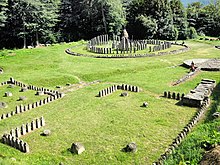Battle of Sarmizegetusa
This article includes a improve this article by introducing more precise citations. (February 2012) ) |
| Battle of Sarmizegetusa | |||||||
|---|---|---|---|---|---|---|---|
| Part of the Dacian Wars | |||||||
 The sanctuaries at Sarmizegetusa Regia, the capital of ancient Dacia (modern Romania) | |||||||
| |||||||
| Belligerents | |||||||
|
|
| ||||||
| Commanders and leaders | |||||||
| Decebalus | Trajan | ||||||
| Strength | |||||||
| 18,000–20,800 | 12 legions | ||||||
Location within Romania | |||||||
The Battle of Sarmizegetusa (also spelled Sarmizegethuza) was a siege of
.Background
After Trajan's First Dacian War (101-2), Decebalus did not respect the peace conditions imposed by Trajan, and in retaliation the Emperor prepared to annihilate the Dacian kingdom and finally conquer Sarmizegetusa in Trajan's Second Dacian War.
It is estimated that the Dacians most likely had fewer than 20,000 men capable of fighting the invasion.[citation needed]
Advance

The Roman forces approached Sarmizegetuza in three main
The second column of the army is believed to have crossed the Danube somewhere near ancient
The combined forces of the two columns then began attacking the area of the
The third Roman column, most likely led by Trajan himself, advanced through eastern Muntenia, crossed the Carpathians at a location close to what is now Bran, and marched westwards through southern Transylvania.[citation needed]
The rest of the troops left from
The Roman forces then enveloped Sarmizegetusa.
Other Roman units are believed to have attacked other Dacian settlements and rally points, as far as the river
Siege
The only historical record of the siege is Trajan's Column, which is a controversial source. There is debate as to whether the Romans did actually fight for Sarmizegetusa, or whether the Dacians destroyed their capital while fleeing ahead of the advancing legions. Most historians agree that a siege of Sarmizegetusa actually took place.[citation needed]
The first assault was repelled by the Dacian defenders. The Romans bombarded the city with their siege weapons and, at the same time, built a platform to more easily breach the fortress. They also encircled the city with a circumvallatio wall.
Finally, the Romans destroyed the water pipes of Sarmizegetusa and obliged the defenders to surrender before they set fire to the city. Roman forces succeeded in entering the Dacian sacred enclosure, hailed Trajan as emperor, and then levelled the whole fortress. Legio IV Flavia Felix was stationed there to guard the ruins of Sarmizegetusa.
See also
- Dacian warfare
- List of Roman battles
References
- Mihai Manea, Adrian Pascu, and Bogdan Teodorescu, Istoria romanilor (Bucharest, 1997), pages 107-122.
- Roman History, books 67-68.
- Jerome Carcopino, Points de vue sur l'ìmpérialisme romain (Paris, 1924).


